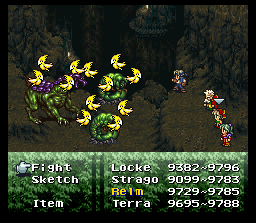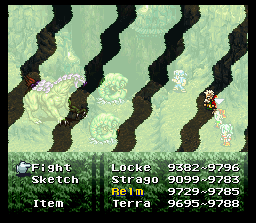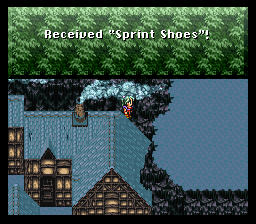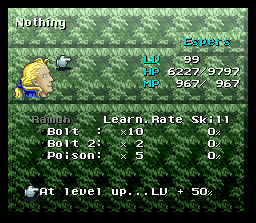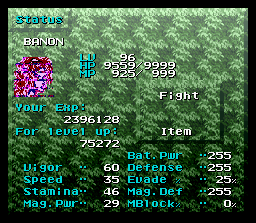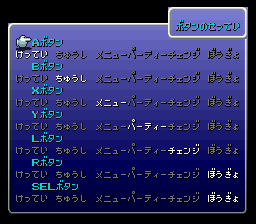Final Fantasy VI
| Final Fantasy VI |
|---|
|
Also known as: Final Fantasy III (US SNES)
|
Final Fantasy VI really needs no introduction. It's one of the finest RPGs ever released for the SNES, if not the entire 16-bit console era. It later saw a PlayStation port, and also a Game Boy Advance port with extra content.
It was originally released in North America under the title Final Fantasy III, but few people call it that anymore.
This game was later retranslated for the GBA as Final Fantasy VI Advance, and these translations are used on some external sources for this game. For easier accessibility, the GBA name of an ability/enemy/other function will appear in parentheses after the SNES name.
To do:
|
Contents
- 1 Sub-Pages
- 2 Unused Enemies
- 3 Unused Command
- 4 Unused Enemy Attacks
- 5 Unused Enemy Data
- 6 Unused Enemy Formations
- 7 Unused Items
- 8 Unused Rages
- 9 Unused Shop Price Modifiers
- 10 Unused Esper Level Up Bonuses
- 11 Unused Graphics
- 12 Unused Fanfare
- 13 Unused Character Data
- 14 Unused Menu Class Names
- 15 Unused Maps
- 16 Oddities
- 17 Regional Differences
Sub-Pages
| Prototype Info |
| Prerelease Info |
| Bugs |
| Unused Dialogue Unused field and battle dialogue. |
| Revisional Differences New additions and features were added in later releases as well as bugfixes and bugs. |
Unused Enemies
These enemies are not used anywhere, and are in various stages of completeness:
CzarDragon
The most well-known of the game's dummied monsters, though there isn't much to the Czar Dragon; it has no battle script, so all it does is attack repeatedly. As it stands, the only noteworthy thing about it is that it uses a different palette from the similar-looking Blue Dragon and Doom Dragon (Fiend Dragon).
There also exists a line of in-battle dialogue related to this enemy, so it was definitely intended to be fought somewhere:
Mwa, ha ha... Humans and their desires! I'm free at last! I bring you destruction... I bring you terror... I am Czar... Prepare yourselves!
Given its incredible likeness to Shinryu from Final Fantasy V, as well as its pre-battle dialogue, it's almost certain that the Czar Dragon was intended to be a similar optional endgame mega-boss. And indeed, that idea was revisited in the Game Boy Advance port, where it was called by its original Japanese name of "Kaiser Dragon", given a unique sprite (similar to the original design but much more elaborate), a full battle script, and made into the ultimate boss of the new bonus dungeon, the Dragon’s Den.
Colossus
This is the closest of the three unused enemies to being complete, but it still has a few signs of being unfinished. Namely, it uses the same palette as the Hades Gigas (Hill Gigas), and has the default "Special" attack, "Hit", which would not be unusual except it actually uses the attack, unlike all other enemies left with said default command. Yes, the Colossus has a full attack script! It uses Fire Wall (Dancing Flame), Lode Stone (Hailstone), Magnitude 8, or the aforementioned "Hit", and when defeated it uses the boss death animation. This, the fact that battles with the Colossus are tagged as inescapable, and with the fact that one of its two unused battle formations uses the boss theme, suggests that it was meant to be a boss.
The Colossus is programmed to counter Blitz and SwdTech (Bushido) attacks, and also targets Gau if he's in the party. This combination of triggers suggests that it was probably originally planned to be fought at some point during Sabin's portion of the "Return to Narshe" sequence early on, but its abnormally high HP (18,000, which is ridiculous for that point) doesn't seem to fit with that. If the Colossus is defeated, it will drop a Bandana.
This enemy is present in the Game Boy Advance version, where it was called by its original Japanese name of "Giant", but is still unused and does not have a Bestiary entry.
Alternate Umaro
Yes, Umaro can be fought normally late in the game, but there also exists an alternate, much weaker version of him in the database. It has only 1,000 HP and a much simpler script (just attacks, uses its special, "Tackle", or casts Blizzard (Snowstorm)), which hints at a possibility that he was intended, at one point, to be fought in the World of Balance, possibly as early as the first time in which you can freely explore Narshe. Like its used counterpart, it is weak to Fire and Poison.
Kefka
A dummy version of Kefka can be found in the game's data, using the Guard sprite (sprite ID 00). Judging from the AI script, he was once used as a dummy enemy with the sole purpose of switching the tiers in the "Tower of Gods" before the actual Kefka fight, but apparently this did not quite work the way the developers intended it to, so the final game uses a hardcoded battle event for the tier switch instead.
Dummied esper
An unnamed, dummied monster that seems to have been another esper for Kafka to battle in Thamasa, as the one formation it appears in features Thamasa Kefka battling it. It uses the Guard sprite and has basic stats. It automatically gets a first strike on Kefka, though the game will then freeze because Kefka has no battle commands.
Dummied cutscene
An unnamed monster that appears to have been created as a cutscene loader. It uses the Guard sprite and has basic stats. If this battle is entered via formation 508, a party consisting of Terra (taking the appearance of Kefka), Locke, Cyan, and Shadow (taking the appearances of soldiers) will be loaded under the screen. Whatever cutscene was supposed to play here does not play, and the battle commences as normal. The enemy will get a First Strike, but is easy to defeat because it has one HP.
Placeholder enemies
There are two unnamed, dummied monsters that can be found in the files of the game. They use the Guard sprite and have a default attack script. They automatically get a first strike on the party, though they are easy to kill otherwise as they have 1 HP. The party cannot escape from these monsters. One of the two enemies can be fought by entering battle formations 490 to 494, while the other is unfightable unless an enemy formation is edited.
Unused Command
In addition to the plethora of commands at your disposal, one of them, "Summon", appears on the surface to have gone unused. When used from the command menu, it can summon the currently equipped Esper as many times as you want, MP permitting, but due to a glitch in the code it can only target the caster. However, Summon is actually the command the game switches to from Magic when the order is given to cast an equipped Esper's spell. This is done in order to show the spell's name instead of the Esper's, for example "Bolt Fist (Judgment Bolt)" instead of "Ramuh". Everything else is found to be identical under either command.
It was likely always meant to simply be part of this background process and nothing more, but the fact that Summon has a name, along with the series' history, creates some doubt as to whether that's true. The previous three games had Summon magic as its own command set, and it could be that the same was planned for this game sometime during development. It could also be that one of the characters would have endless summoning capability of their Esper as their special command, given the state Summon was left in menu-wise.
Unused Enemy Attacks
Several enemy attacks are not used in any way. These skills are not found in any enemy AI scripts, are not used by any Rages, and Relm cannot produce them with either Sketch or Control.
Confusion
As its name suggests, this spell causes Confuse status on all enemies. This is one attack that it's for the best never appeared in-game, given that the Confuse status is incredibly dangerous in this game, and this would be the only mass confusion spell in the game (barring a very unlucky hit by L.3 Muddle (Level 3 Confuse)) that could be used against you. It uses the same "swirling birds" animation as other confusion spells.
Heart Burn (Digestive Fluid)
This is an alternate "spell" version of a similar attack used by Crawlies. This particular variant has the same animation, but can target all enemies and does non-elemental damage rather than causing Seizure status.
Clear (Vanish)
This is a particularly strange, unfinished spell. When used, it inflicts Blind, Poison, Imp, Doom, Silence, Confuse, Sap, Sleep, and Stop on the caster. It also uses a strange wavy animation not seen anywhere else in the game. It shares its GBA name with the Vanish spell granted by the Phantom esper.
Critical
This is the Veteran (Ahriman)’s special attack, but it never uses it in its AI script. Its formula is Level 3=Attack x2.5.
Hit (Version 1)
Hit is the default special attack for enemies who do not have unique special attacks. None of these enemies besides Colossus (who is unused anyway) use this ability in their AI scripts. The enemies who have this ability are Dark Force, White Drgn (Holy Dragon), Bomb, Magic Urn, Trixter (Clymenus), Whelk (Ymir)’s shell, Presenter (Angler Whelk)’s shell, Shiva, Ifrit, Guardian, Air Force, Valigarmanda, Flame Eater, Nelapa, Hidon, L.30 Magic (Level 30 Magic), Goddess, L.40 Magic (Level 40 Magic), L.20 Magic (Level 20 Magic), Siegfried (Phantom Train), L.10 Magic (Level 10 Magic), L.50 Magic (Level 50 Magic), Colossus, CzarDragon, L.60 Magic (Level 60 Magic), Merchant, B.Day Suit (Birthday Suit), L.70 Magic (Level 70 Magic), Laser Gun, Speck (Bit), Missile Bay, Kefka (Narshe), Grunt (Soldier), Opinicus Fish, Tools (Machine), Magic, L.80 Magic (Level 80 Magic), L.90 Magic (Level 90 Magic), Magic Master, Kefka (Imperial Camp), Cyan (Imperial Camp AI), Zone Eater, Gau, Kefka (Thamasa), Officer (Cadet), Imperial Soldier (Terra’s flashback), Unnamed Ifrit palette swap, Atma Weapon (Ultima Weapon), and Shadow (Coliseum AI). Its formula is Level 1=Attack x 1.5.
Hit (Version 2)
An alternate version of Hit, used for the same purpose. It is stronger than the first version. The enemies who have this ability are Curley (Curlax), Larry (Laragorn), Moe (Moebius), and Ice Dragon. The formula for this attack is Level 2=Attack x 2.
Hit (Version 3)
Another alternative version of Hit, used for the same purpose. This attack is only in the AI scripts of Whelk (Ymir)’s shell and Gold Drgn (Gold Dragon.) Its formula is Level 6=Attack x 4.
Hit (Version 4)
A version of Hit that inflicts Poison. It is only in the AI scripts of Chupon (Typhon)’s appearance on the Blackjack.
Hit (Version 5)
A version of Hit that inflicts Doom. It is only in the AI scripts of Chadarnook’s demon form.
Hit (Version 6)
A version of Hit that removes Reflect. It is only in the AI scripts of Skull Drgn (Skull Dragon).
Hit (Version 7)
A version of Hit that inflicts Osmose. It is only in the AI scripts of Blue Drgn (Blue Dragon).
Impmare
An unused special attack for the Whisper (Angel Whisper) that inflicts Imp.
Imp Goo
An unused special attack for Chupon (Typhon)’s Coliseum appearance that inflicts Imp.
PoisonTusk (Venom Tusk)
An unused special attack for Didalos (Daedalus) that inflicts Poison.
Unused Enemy Data
Leap Protection
Normally, when Gau is on the Veldt, the Leap command can fail under two circumstances:
- Gau is the only member of the party.
- Gau is not the only member of the party, but all other party members are considered dead (either fainted, zombified, or petrified).
However, a third case is also coded. The enemy formation data in the game has a bit that, if set, will prevent Gau from leaping on the enemies in this formation if encountered on the Veldt. However, no enemy formation actually has that bit set, so it goes completely unused. It's unknown what its purpose was.
Joker Doom Protection
The enemy formation data in the game has a bit that, if set, will prevent Setzer from getting triple 7 with his Slots command, effectively preventing these enemies from getting hit by Joker Doom.
The list of enemy formations that have this bit set is actually pretty haphazard and suggests that this bit once had a different purpose than just preventing instant death attacks. More importantly, Whelk (Ymir), Vargas, Ultros (Lete River encounter), and Rizopas (Rhizopas) all have the bit set, but these bosses appear before Setzer joins the party, so the behavior remains unseen.
Unused Enemy Behavior
Every enemy has an AI script, but a few of them show interesting oddities:
- Dadaluma has a check where he will not whistle for two Iron Fists if he's been muted. This is impossible in normal play because you don't get Espers until after this fight, no Rage or other command you can get at this point can set Silence, and the only natural magic user you can have in this fight, Celes, does not learn Mute naturally.
- The FlameEater (Flame Eater) is programmed to counter Demi (Gravity) or Quartr (Graviga) with either Quartr or Flare. This can never happen because the FlameEater is actually completely immune to these spells, and as such the counterattack is never triggered.
Unused Enemy Formations
| To do: * Video of the unused Kefka scene and images for other battles. |
The following enemy formations are never encountered during the course of the game.
| Number | Enemies | Notes |
|---|---|---|
| 42 | B. Day Suit (Birthday Suit) | This "enemy" is only used when Locke steals the clothes from a merchant or soldier in South Figaro, but it can't actually be encountered in its own right. |
| 48 | Doberman x2 Soldier (Imperial Soldier) |
The Doberman is only encountered by kicking a chest in the Imperial Camp, and can’t be encountered with other monsters. |
| 58 | Templar x2 | Normally fought in the Imperial Camp. |
| 127 | Wizard | Wizards are normally fought in the Narshe Mines. |
| 129 | Sprinter Lunaris (Luna Wolf) |
Sprinters and Lunarises are normally fought in the World of Ruin. |
| 130 | Chitonid (Murussu) Sprinter |
Chitonids are also fought on the World of Ruin. |
| 131 | Sprinter x3 | More Sprinters. |
| 132 | Chitonid Woolly (Baalzephon) |
Later used in the Game Boy Advance-exclusive Soul Shrine. Woolies are normally fought in Zone Eater’s belly. |
| 133 | Chitonid Lunaris x2 |
Not very interesting. |
| 174 | Gigantos x2 | Normally only occurs as a monster-in-a-box on the Floating Continent. Later used in the Game Boy Advance-exclusive Soul Shrine. |
| 208 | HermitCrab (Zokka) Scorpion |
HermitCrabs and Scorpions are fought in the Crumbling House. |
| 283 | Souldancer (Blade Dancer) Vindr (Caladrius) x2 |
Souldancers and Vindrs are fought in Owzer’s House (Owzer’s Mansion). |
| 344 | Aquila (Galypdes) | Galypdes are fought in the Phoenix Cave. |
| 345 | Trixter (Clymenus) Necromancr (Necromancer) x3 |
Trixters and Necromancrs are fought in the Phoenix Cave. |
| 358 | Gobbler (Lenergia) Flan x3 |
Gobblers and Flans are fought in the Magitek Research Facility. |
| 359 | Chimera Gobbler |
Chimeras are fought in the forests outside Thamasa. |
| 390 | [no name] (Kefka) | This is an unused cutscene where Kefka and two soldiers dodge flying Espers at the Sealed Gate. |
| 453 | Kefka | This is the "character sprite" form of Kefka as fought in the Imperial Camp and the Cave to the Sealed Gate, but it's set to play the boss theme rather than the regular battle theme. |
| 467 | Inferno | This formation is the Inferno boss without his two arms (as opposed to the used formation which also has the two arms). |
| 488 | Tritoch (Valigarmanda) | Identical to the Tritoch fought in the World of Ruin (formation 487), but this formation plays the battle theme rather than being silent. |
| 489 | Ice Dragon Kefka |
This is the "monster" form of Kefka, using the sprite and stats from the Narshe fight. When compared to the time when Kefka is fought normally, the Ice Dragon is insanely overpowered compared to Kefka. |
| 490 | [no name] | A placeholder for a never created cutscene. The enemy (using the Guard sprite) has 1 HP and does nothing besides attack. |
| 491 | [no name] | Same as 490. |
| 492 | [no name] | Same as 490. |
| 493 | [no name] | Same as 490. |
| 494 | [no name] | Same as 490. |
| 495 | [no name] | Same as 490. |
| 497 | [Ifrit palette swap] | Even though Kefka is not present in this formation, the event will still play as if he were there, with the Esper being transformed into Magicite. This formation plays the battle theme. |
| 498 | [Ifrit palette swap] | Duplicate of the above. |
| 503 | Cadet (Officer) | Cadets are fought in the Imperial Camp in a scripted encounter. This formation is almost 450 formations away from the used formation (which is 059.) |
| 506 | L. 60 Magic (Level 60 Magic) | L. 60 Magics are normally fought in the Tower of Fanatics. This enemy formation tries to set an unknown event flag relating to Kefka and Terra (?). |
| 508 | [no name] | Same as 390, but instead of a cutscene an ordinary battle starts. All your characters are hidden from view and use Kefka's and the soldiers' graphics. |
| 509 | [no name] | Possibly meant for a second Esper battle. Battle freezes at the first turn because control turns to Kefka, who has no commands. |
| 510 | [no name] (Kefka) | A duplicate of the Kefka vs. Gestahl battle on the Floating Continent. The enemy is not targetable so there is no way to win the battle. |
| 526 | Guardian x4 | This is the Guardian enemy that can be defeated at Kefka's Tower. This formation uses the battle theme, not the boss theme. |
| 527 | Scullion (Gamma) x2 | Scullions are normally fought in Kefka’s Tower. |
| 529 | IronHitman (Metal Hitman) Scullion Junk x2 |
IronHitmen and Junk are fought in Kefka’s Tower. |
| 530 | Prometheus Fortis |
Prometheuses and Fortises are fought in Kefka’s Tower. Later used in the Game Boy Advance-exclusive Soul Shrine. |
| 531 | Fortis x3 | More Fortises. |
| 532 | Dueller (Dual Armor) Sky Base (Death Machine) Fortis |
Duellers and Sky Bases are fought in Kefka’s Tower. |
| 536 | Outsider x2 Dark Force Madam (Cherry) |
Outsiders, Dark Forces, and Madams are fought in Kefka’s Tower. Later used in the Game Boy Advance-exclusive Soul Shrine. |
| 539 | Steroidite (Muud Suud) Mover x3 |
Steroidites and Movers are fought in Kefka’s Tower. |
| 540 | Didalos (Daedalus) x2 Veteran (Ahriman) x2 |
Didalos and Veterans are fought in Kefka’s Tower. |
| 541 | Didalos x2 Outsider |
More Kefka’s Tower unused formations. |
| 542 | Retainer (Yojimbo) x2 Veteran x2 |
Retainers are fought in Kefka’s Tower. |
| 546 | Vectagoyle (Vector Chimera) Brontaur (Primeval Dragon) |
Both enemies are fought in Kefka’s Tower. |
| 550 | Evil Oscar (Great Malboro) x4 | Evil Oscars are fought in Kefka’s Tower. |
| 551 | Vectaur (Vector Lythos) x6 | Vectaurs are fought in Kefka’s Tower. |
| 553 | Ice Dragon x5 | 5? No clue where this would have been used. |
| 575 | Pugs (Tonberries) | This is actually a placeholder formation used for the Coliseum battles, where the Pugs enemy is replaced with the appropriate contender. Attempting to load this formation outside the Coliseum will lead to a default battle against a single Guard. |
Unused Items
Key Items
There are seven unused key items lurking in the game. None of them have any effect.
| Japanese | Translation | English | Notes |
|---|---|---|---|
| じょゆうのサイン オペラ女優のサイン |
Actress's Autograph An opera actress's autograph. |
Autograph An opera singer's autograph |
Seems to relate to the Opera House sequence. |
| マニキュア きれいな赤のマニキュア |
Nail Polish Lovely red nail polish. |
Manicure Pretty, red manicure |
Seems to relate to the Opera House sequence. |
| オペラのレコード ちょっときずがある |
Opera Record It's a little scratched. |
Opera Record Has a small scratch |
Seems to relate to the Opera House sequence. |
| むしめがね とつレンズ |
Magnifying Glass A convex lens. |
Magn.Glass A convex lens |
It's completely unknown what you were meant to use this for. |
| めずらしいいし 見たこともないような石 |
Curious Stone A stone unlike any you've seen before. |
Eerie Stone A stone never seen |
This may have been a Magicite. It's possible you were intended to obtain one as a key item before you knew what they were. |
| へんな え ふしぎなだまし絵 |
Strange Painting A marvelous trompe l'oeil. |
Odd Picture A very curious picture" |
This and the following item may pertain to Owzer's house, possibly as part of the quest to get Relm in the World of Ruin and/or the battle with Chadarnook. |
| かみきれ 何のへんてつもない絵 |
Piece of Paper A completely unremarkable picture. |
Dull Picture Quite a common picture |
While a scrap of paper does appear as part of a little event in the Returners' Hideout, it's never added to your inventory. |
Obviously, the potential use for all these items is open for debate. They're likely just leftovers from scrapped quests.
Inaccessible Fairy Ring
A very little-known fact about Final Fantasy VI is that a Tent can be found by examining a completely inconspicuous spot on the floor in one of the small rooms aboard the Phantom Train. Even less known, however, is that a Fairy Ring is in this same room... and is completely unobtainable. In order to pick up the items on the floor in this room, you have to be facing - but not standing on - the tiles they're hidden on. This can be done for the Tent in the upper-left corner of the room, but not for the Fairy Ring on the floor right next to it, as the positioning of the sofa and table make actually facing this square impossible. Only via walk-through-walls codes (or modifying the room via an editor) can this item be obtained.
In the iOS and Steam versions, due to a change in the way movement is handled, this item can be properly collected (though it was changed to a Tonic (Potion).
Unobtainable Behemoth Suit
The two different versions of SrBehemoth (Behemoth King) (living and undead) are both supposed to drop a BehemothSuit (Behemoth Suit) 100% of the time, but due to a glitch in how the game switches from the formation with the living SrBehemoth and the formation with the undead version, this never actually happens, and you receive either a ThunderBlade (Thunder Blade) or a Jewel Ring (Jeweled Ring) (in the original US release, at least; the latter items vary by release, but the point is that you don't get the other BehemothSuit). This is fixed in the Game Boy Advance release.
Unused Metamorph Sets
Ragnarok's "Metamorph" skill is one of the game's oddest curiosities: it has a formula all its own, it behaves unlike any other skill in the game, and each enemy has a few bytes in its data relating to this one skill's effect. If successful, it kills an enemy instantly and transforms them into one of four items in a preset package, which you then obtain. Each enemy is assigned one of these "packages", but despite the sheer number of enemies in the game, as well as the relatively small number of Metamorph packages, three of them went unused.
| Morph Set #12 | Morph Set #13 | Morph Set #15 |
|---|---|---|
| Tonic (Potion) | Tonic (Potion) | Tonic (Potion) |
| Tonic (Potion) | Tonic (Potion) | Tonic (Potion) |
| Tonic (Potion) | Tonic (Potion) | Tonic (Potion) |
| X-Potion | X-Ether | Gauntlet |
Of these, the only thing of any real note is that Metamorph Set 13 includes an X-Ether, of which there are otherwise only a few in the game. It's not known why these Metamorph sets were left out.
Inaccessible Stolen Items
The Dullahan boss fought early in the World of Ruin has two items available to steal (common X-Potion, rare Genji Glove), but it is absolutely impossible to steal from this particular boss, rendering these items inaccessible. You don't/can't have Locke or Gogo in the team, nobody in the current team can equip the Thief Knife (Thief’s Knife), and there's simply no way to obtain a Merit Award at this point due to the simple reason that none of the items that lead to it at the Coliseum can be obtained yet.
Dullahan appears in the Soul Shrine in the Game Boy Advance port, however, and can be stolen from normally.
Inaccessible Sprint Shoes
There's a pair of Sprint Shoes located near the back door of Arvis' house in Narshe in the World of Balance that cannot be acquired because it's one tile out of bounds.
Unused Rages
There are four slots in Gau's massive Rage command that can't be filled:
- Siegfried - The mysterious swordsman who appears occasionally throughout the game, doing nothing important. This Rage is supposed to be for the stronger version that can be fought in the Coliseum, not that silly weakling fought on the Phantom Train, but as the coliseum enemies are not programmed to appear on the Veldt, it's not possible to get it. Its special move is Flare, which while somewhat nice, is offset by the fact that this Rage makes Gau weak to all eight elements.
- Chupon (Typhon) - Ultros' friend with the serious allergy problems. This is basically the same deal as Siegfried: The Rage is of the stronger version in the Coliseum, but again, Coliseum enemies don't appear on the Veldt. Those who were hoping this Rage would use Sneeze (Snort) are going to be extremely disappointed - the special skill here is W Wind (Tornado), which is handily one of the most useless spells in the game. You're not missing out on anything by not being able to use this Rage, in other words.
- Allo Ver (Death Warden) - The odd skeleton monster guarding the Tiger Fangs (Tigerfang) in the Cave on the Veldt appears in two battle formations. Only one of them is eligible to appear on the Veldt, but the other one is what's actually used, so Allo Ver never makes a repeat appearance. This could be a coding mistake, or there may have been other plans for the first formation that were scrapped. The Rage itself makes Gau undead, weak to fire, and its special move is Quake. Not bad, but not really an important loss, either. In the Game Boy Advance port, the formation in the cave is unchanged, but it's possible to encounter this monster in the GBA-exclusive Soul Shrine, where it uses the other formation and can as such appear on the Veldt.
- Pugs (Tonberries) - This is the monster-in-a-box variation with a group of three, not the individual random encounter variation. You can technically get these as a Rage, and in the Game Boy Advance port they can even be viewed on the Rage menu, but they occupy the final slot on the Rage list, which, due to the way the command is set up, can't be selected. And it's a shame, too, as their special is Knife, a physical attack that's even more crazy powerful than Catscratch (Cat Scratch). Although since that attack usually does 9999 damage anyhow, this may be a tad redundant.
Unused Shop Price Modifiers
It's common knowledge that the prices of the shops in Figaro Castle are halved if Edgar is in the lead of the party. However, there exist two other bits of code to modify shop prices that weren't used anywhere. One straightforwardly doubles prices, while the other adjusts prices based on the current party leader's gender: females get half prices, and males get a 50% markup (Gogo is treated as a male).
These price modifiers can be hacked into the game via editors, and work perfectly. The one that doubles the prices could have been used in Thamasa before you talked to Strago. It's unknown where the other one could have been used.
Unused Esper Level Up Bonuses
There are four level up bonuses granted by Espers that went unused.
- Speed +2 - No big mystery as to what this one does. Odin raises your speed by one point at level up, but no Espers boost it by two. This effect was later used in the Game Boy Advance port, as Cactuar's level up bonus. In the Pixel Remaster version of the game, this is used as Odin’s level up bonus, and Palidor (Quetzalli) raises speed by one instead.
- HP +100% - This works the same as the other HP+XX% bonuses, except, well, it's +100% instead of +10/30/50%. Simply put, if your max HP went up by 60 points at level up, this bonus would boost it to 120. This is also used in the Game Boy Advance port, by Diabolos.
- LV +30% - No clue how this would have worked, as it has no (useful) description and doesn't seem to do anything. Perhaps it would raise all stats?
- LV +50% - A stronger version of the above bonus, presumably, but it still does nothing.
Unused Graphics
Character Sprites
![]()
Normally, when Terra gets KO'ed in Esper form she immediately reverts to human form, seemingly rendering this sprite unused. However, there is one instance in which it can be seen: during the final Phunbaba (Humbaba) fight, when Terra is permanently in Esper form, she does not revert when killed.

This menu portrait for Terra in Esper form can be found alongside the other character portraits in the PlayStation version. It was scaled down to 34×34 in the Game Boy Advance version and used for Terra's dialogue when she is an Esper.
![]()
Magic chanting animations for Umaro, General Leo, brown and green imperial soldiers, the ghost ally, and a wandering merchant. Umaro is uncontrollable, and as such cannot learn magic; Leo, Vicks/Biggs, the ghosts, and Wedge have no magic (or magic-based commands) during the brief time they're playable; and magic does not come into play until long after the scenario in which Locke can dress as a soldier or merchant.
It's possible, however, to see one of the frames of Umaro's chanting stance normally in at least one place: When collecting the Palidor (Quetzalli) Magicite, the lead character will stand in their chanting pose until the text box disappears. As a result, if Umaro is in the lead at this time, he will use this otherwise-unseen stance.

Not only do Chupon (Typhon) and Hidon have the same sprite (palette differences aside), it's also fully animated! Normally, only a single left-facing frame of Chupon is visible as he approaches the airship during the air attack as you're heading for the Floating Continent, while only the forward-facing sprite of Hidon is seen (and even that is obscured slightly by the darkness). The upward-facing sprite is unused entirely.
Objects
![]()
This book graphic is included in the sprite data but isn't used anywhere in the game. Several palettes look decent with it, but no one palette looks perfect.
![]()
The graphic of Locke's bandana, with the correct palette applied to it. Present in the ending normally, but as the entire ending sequence is in greyscale, its actual appearance is never seen.
Tiles
![]()
It's... some kind of hole, with what appears to be a rope leading down it. This is present in the "ruined" village tileset (used in Kohlingen and Thamasa), but does not appear to actually be used anywhere.
![]()
Mixed in with the fence tiles in the two village tilesets is this closed gate. It's pretty obvious where it would have been used, but all the gates you'll come across in villages are opened and stay that way. This graphic is actually two tiles, and only in the "normal" village tileset (Mobliz, among other places) does the whole thing appear; the top part of the gate is missing in the "ruined" village tileset mentioned above.
![]()
These chain graphics are located in the "mountain cave" tileset but are never used. Given there are two frames, and they're located right below the floor switches in the tileset, it's a safe guess these were going to be wall switches, not unlike the ones with the skull motif in the standard caves.
![]()
The skull switches themselves also have an unused frame! This graphic should be used when the switches are flipped, but for some reason, this never actually happens. The Game Boy Advance port reinstates these graphics.
![]()
An item shop sign found in the Zozo tileset. Despite not actually having any shops, signs for weapon, armor, and relic shops, as well as inn and café signs, are present around Zozo, but there's no item shop sign to be found. A graphic similar to this one is used in the Zozo battle background, but the tile never appears in the town itself.
![]()
Some kind of crude fence found in the desert camp tileset. The Imperial Camp near Doma is the only place in the game that uses this particular tileset, and this particular type of fence is never seen there. If not a fence, it could also be a pike rack.
![]()
Also found in the desert camp tileset is this... thing. No idea what it's supposed to be. Probably a decorative placard or sign, or even possibly a radio of some sort.
![]()
An incomplete set of off-palette shop signs found in one of the castle tilesets. The only castle that has shops of any kind is Figaro, and no signs are used to mark their presence. Furthermore, these signs only appear in the alternate tileset used for "dungeon" castles (such as the Ancient Castle and Figaro Castle's basement) and not the normal castle tileset, raising further questions about how they may have been intended to be used.
![]()
This strange object resembling a broken chimney is something of an enigma: It isn't actually unused, but is so obscure that it may as well be. This object only appears once in the entire game, in Maranda, and is only visible in full if you stand in one very specific spot. It's just mere background decoration, however, and serves no purpose whatsoever, so why go through all the trouble to hide it?
Unused Fanfare
There exists, mixed in with the game's music, a single unused fanfare. It's a short victorious cue, used as the "get important item" jingle in Final Fantasy I, II, III, and V. Why it was left out of VI is unknown.
This song is also present in the Game Boy Advance port. However, while it remains unused in-game, it can be heard on the music test unlocked after the game is beaten once, where it is titled "Fanfare 2". The song was even given a new rearrangement for the release of the Pixel Remaster version, though it still goes unused in-game besides its appearance in the sound test.
Unused Character Data
Kefka
The game's data contains seven copies of Kefka as a party member. These are used for the Kefka fights at the Imperial Camp and Cave to the Sealed Gate, as well as various cutscenes.
Shortly before any of these scenes start, Kefka is "added" as a party member by script. As with any member that joins your party, his level and thus his HP/MP are set to your party's average, though this is only relevant for the Sealed Gate fight (as Kefka's battle script in the Imperial Camp ends the battle immediately if he's damaged in any way). After the last scene (which is the fight with the Ifrit palette swap), Kefka stays present as a hidden party member permanently. It is possible to hack him into your party, although it's not terribly useful because the game freezes as soon as his turn comes up in battle. He also has no character portrait, instead falling back to Terra's. (This was changed in the Game Boy Advance version which added character portraits to dialog boxes, giving Kefka a portrait as well in the process.)
All seven copies have different base stats and different equipment, but only four are actually used:
- Kefka 1 (Morning Star/Mythril Helm/Mythril Vest/Ribbon) is the weakest of the bunch and fought at the Imperial Camp. He's also the version of Kefka that appears during Terra's flashback.
- Kefka 2 (Morning Star/Mythril Helm/Mythril Vest/Ribbon) is slightly stronger than the above and fought at the Sealed Gate.
- Kefka 3 (Morning Star/Paladin Shield (Paladin’s Shield)/(empty)/Ribbon) is by far the strongest character with ridiculous base stats. This version fights the Ifrit palette swap in Thamasa.
- Kefka 4 (Morning Star/Mythril Helm/Mythril Vest/Ribbon) has the same stats as Kefka 2 and is only used in the fight with General Leo.
The following three copies of Kefka go unused (they all have the same stats as Kefka 2):
- Kefka 5 (Morning Star/Mythril Helm/Mythril Vest/Ribbon)
- Kefka 6 (no equipment whatsoever)
- Kefka 7 (no equipment whatsoever)
To allow Kefka to be added to your roster, use Game Genie code DD5C-740D at any point where you can freely switch characters and enter any character select screen.
Maduin
Despite the fact that Maduin never enters any battles during the brief time he's playable, he has a full set of stats and a basic command set (Fight/Item). Neither of these are normally visible because the menu is disabled during this sequence. Other characters that were never meant to enter a battle (e.g. Kefka) do not have any command set at all and will thus freeze the game when their turn comes up in battle. He also has a pair of Sprint Shoes permanently equipped.
To allow Maduin to be added to your roster, use Game Genie code DD5C-740D right after getting the airship in the World of Balance and enter any character select screen.
Mystery Character
One other odd character exists in the game's data, although it doesn't appear it can be hacked in. The character's name is nothing but a series of question marks, its equipment is a Blossom (Sakura), Mithril Shield (Mythril Shield), Mithril Helm (Mythril Helm), and Ninja Gear, and its command set is simply Fight/Magic/Item. The Blossom and Ninja Gear point to this character being an alternate version of Shadow; perhaps at some point in development, it was possible to get him to join before actually naming him, although this would be odd given the Magic command being present. Alternatively, like Kefka, who has player character data associated with him because you fight him in "character sprite" form, it's possible this mystery character's data is used as the version of Shadow you fight in the Coliseum when you bet the Striker (Ichigeki) or Gestahl when he fights Kefka.
Unused Character Names
Listed at the very end of the character data is a set of 16 unused names. They're probably just placeholders, although it's possible that these were meant for additional characters, or they could have been intended for another large-scale battle such as the one early on in which the Moogles help Locke protect Terra. However, as none of these characters were actually programmed into the game, it's completely unknown exactly what purpose they would have served. All of them have nothing but Dirks (Daggers) (a default value) in every equipment slot.
- TORK / トルク (Toruku)
- JADE / ジェイド (Jyeido)
- CUSTER / カスター (Kasutaa)
- FABIAN / ファビアン (Fabian)
- DRAKE / ディック (Dikku (Dick))
- SERA / セラ (Sera)
- CASE / ケイス (Keisu)
- SIELE / シィル (Shiiru)
- RAY / ライ (Rai)
- REIKER / ライク(Raiku)
- LANCE / ランス (Ransu)
- BOB / バブ (Babu)
- PEPPER / ぺたぺた (Petapeta)
- TAU / たうー (Tauu)
- VICTOR / ビクター (Bikutaa)
- HO / ホー (Hou)
Unused Menu Class Names
Value 0E, しんかん shinkan (Fusion), seems reserved for Terra, but this is impossible to display because you are never in a state where a morphed Terra can access the menu in any version. Enter Pro Action Replay (PAR) code 7E16000E to see this on Terra in the Japanese version.
Values 22-28 display へいし heishi (Soldier). The used ていこくへい teikoku-hei (Imperial Soldier) is applied to Biggs and Wedge, but there are six more of these that don't seem to correspond to any playable character at all.
Unused Maps
There are several unused maps, but map 0x10B is the most interesting because it has two exits on it. For the most part, it is identical to 0x10D, the long staircase in the Magitek Research Facility. However, both exits lead to areas of Kefka's Tower. If the map had been used, the player would climb the long staircase after defeating Poltrgeist (Demon), then after reaching the top they would drop down a hole as normal to reach the final room in the dungeon. However, the size of this staircase doesn't really match the exterior of the tower, which might be why it was dummied out.
Oddities
Tent skip
When a Tent is used on the overworld, the game transitions to a pitch black map for the tent cutscene. This map has a trigger for the cutscene where the Floating Continent emerges, located just one tile below the party. It is possible to gain control of the party during the tent cutscene and move to this tile, breaking the game's normal storyline progression (for example, this is used in the "New Game +" speedrun route). It's completely unknown why this event trigger is placed there; it's possibly a leftover from the game's development.
Used text that shouldn't be
Visiting Gau's father with Gau and Sabin in the party triggers a long cutscene. If at this point you have the Emperor's Map (which gives Locke's location) but haven't recruited Locke, some additional dialogue occurs. A party member shows Gau's father the map, for no particular reason, and he describes the mountain range that the item's description already mentions. The old man doesn't react to the map outside the context of this cutscene. Most likely the map originally pointed to Gau's father's home instead of the Phoenix Cave. When the change was made, the old man's direct reaction to the map was removed, but its mention in this cutscene was mistakenly left in.
Regional Differences
Various changes from the Japanese version to the North American version.
Title Screen
| Japanese | North American (SNES) |
|---|---|
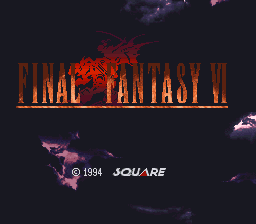 |
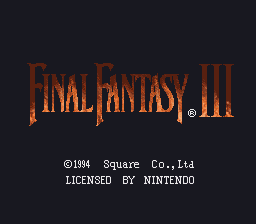 |
Besides the different numbering, the SNES version got a new title logo based on the one being used on the US box art for the series at the time. The copyright information was updated and an ® mark was added.
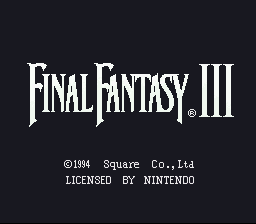
In addition, the SNES version displays a white logo screen before the main title while the Japanese version directly opens with the title sequence.
Graphics
| To do: GBA rips, where needed. |
Several graphics were redrawn or modified for the North American release on the SNES, usually due to Nintendo of America's censorship policies at the time. The PlayStation port uses the original Japanese graphics in all regions. Oddly, Final Fantasy VI Advance would later mix and match censored and uncensored graphics outside Japan.
Magic/Summon Animations
| Japanese | North American (SNES) |
|---|---|
The "medal" that appears when the Mute spell is cast was a bit wider and rounder in the Japanese version and read, appropriately enough, "Silence". Strangely, the PlayStation and Game Boy Advance ports use the Japanese version's graphic even in the English versions.
| Japanese | North American (SNES) |
|---|---|
The Esper Siren was naked from the waist down in the Japanese version. The censors made her put on some shorts in the western release. A similar but more subtle change was made in the western releases of Final Fantasy VI Advance, which added some additional cloth to cover her butt.
| Japanese | North American (SNES) |
|---|---|
 |
 |
The Esper Starlet/Lakshmi was more revealing in the Japanese version. The censors added some fabric for the SNES release, to make the cloth originally covering her look more like a dress.
Monster Graphics
| Japanese | North American (SNES) |
|---|---|
 |
 |
The enemy Critic/Alluring Rider wears a two-piece outfit in the Japanese version, which kind of makes her look naked from the waist down. This was changed into a unitard in the SNES release.
| Japanese | North American (SNES) |
|---|---|
The object held by the "Madam (Cherry)" enemies in Kefka's Tower (along with their palette swaps "L. 80 Magic (Level 80 Magic)", "Dahling (Misty)", and "Barb-e (Coco)") was much more clearly a pipe/long fancy cigarette in the Japanese version. The SNES version removes the plume of smoke.
| Japanese | North American (SNES) |
|---|---|
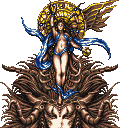 |
 |
The Goddess had a bit more skin exposed in the Japanese version, which was covered with additional fabric for North America.
| Japanese | North American (SNES) |
|---|---|
 |
 |
More censorship in action. The "goddess" half of Chadarnook had a bit more skin exposed in the Japanese version, which was covered with additional mist in the SNES version. The Game Boy Advance version was similarly censored but does not reuse the sprite from the SNES version.
| Japanese | North American (SNES) |
|---|---|
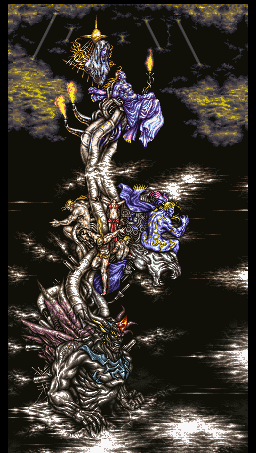 |
 |
Two of the three tiers of the "tower of gods" leading up to Kefka were censored in the North American release. In the second tier, "Magic" was subtly censored with a darker palette around his groin, more noticeable however is the censored appearance of "Hit (Power)" who wears a loincloth and the female figure near him which was similarly censored with clothing offering more coverage. And lastly, in the third tier, the "Girl/Lady" (Maria) was altered in order to make her breasts much less noticeable.
Other Graphics
| Japanese | North American (SNES) |
|---|---|
In a move that should surprise nobody given the censorship present in that era, the pubs in the Japanese version were changed into cafés in the SNES version. Oddly enough, the sign inside the pubs/cafés, showing a wine bottle and some shot glasses, was not altered.
| Japanese | North American (SNES) |
|---|---|
 |
 |
As can be seen in the upper-left corner, the pub sign was changed to a café sign in the Zozo battle background as well.
| Japanese | North American |
|---|---|
The weapon sign in Vector was slightly tweaked for the North American release. Both are quite crude looking and, besides their different palette, don't match their equivalent seen in other towns: ![]()
| To do: How were these handled in the PS1 and GBA releases? |
The armor and inn signs in Vector match their counterparts in other towns, outside of their palette being different.
| Japanese | North American (SNES) |
|---|---|
The icons for attack and support magic were, for some reason, mirrored for the SNES release.
| Japanese | North American |
|---|---|
Due to the limited screen space, the North American version uses icons to describe the different elements. The Japanese version simply uses a kanji for each element (水=Water, 地=Earth, 聖=Holy, 毒=Poison, 風=Wind, 雷=Thunder, 氷=Ice, 炎=Flame).
Menus
Customization
Two menus were removed from all releases outside Japan.
The Super Famicom and PlayStation versions allowed the player to customize the controls.
| To do: Is there a remnant of this menu in the localized GBA versions? |
The Japanese version allowed the player to rename Cyan's eight Swordtech (Bushido) abilities.
Item Menu
| Japanese | North American (SNES, PS1) |
|---|---|
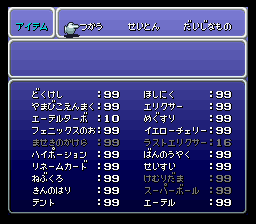 |
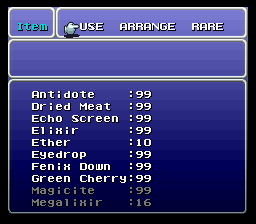 |
Like other titles in the series, the item menu in the Japanese version is organized in two columns which makes it easier to navigate quick in battle with less scrolling. It was reduced to a single column in the North American version due to space constraints when item names were expanded from eight characters to 12.
In addition, weapons armor and relics got an additional description next to them (SWORD, SHIELD, TOOLS, etc.) in the SNES version.
Magic Menu
| To do: This covers SNES and PS1, but GBA made changes to this menu too. |
| Japanese | North American |
|---|---|
 |
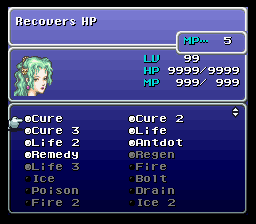 |
Similar to the item menu, the Japanese version's magic menu is organized into three columns instead of two. The three different categories of magic are also more clearly separated in the Japanese version. In the North American version the MP cost window was moved to leave room for a larger description window, which in turn condensed the magic window in height. The latter was altered on all other ability menus as well, where the MP cost window instead said Espers, SwdTech, Blitz, etc. (This changed menu layout, in turn, introduced several visual bugs in the North American versions; see here.)
Lore Menu
| Japanese | North American |
|---|---|
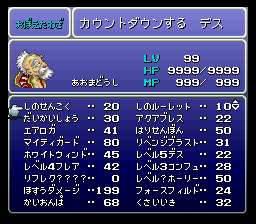 |
 |
Like the aforementioned ones, Strago's Lore menu was reduced to a single column in the North American version, which made navigating the menu quickly in battle a bit more cumbersome.
Equipment and Accessories Menus
| Japanese | North American |
|---|---|
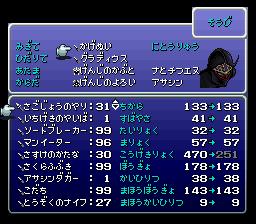
|

|

|
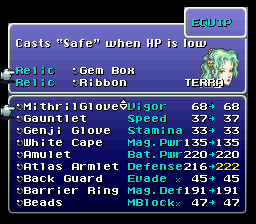
|
In the Japanese version, the Equipment and Accessories (Relics) menus display the amount of each equipment you own, this was unfortunately removed due to space constraints when item names were expanded in the North American version. Also, in the Japanese version, the select cursor was positioned right before the equipment, in the North American version it was moved to the far left. Finally, the message にとうりゅう which indicates if the character is equipped with one weapon in each hand was removed along with the character class name, and the character name was instead written over their portrait.
Party Equipment Screen
| Japanese | North American |
|---|---|
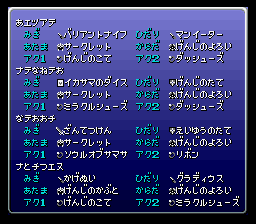 |
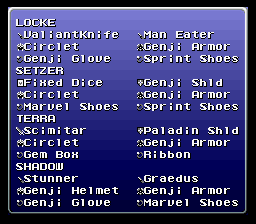 |
The Party Equipment screen was also slightly modified due to the limited space available - the text that said Head, Body, etc. was removed in the North American version.
Battle Windows
| Japanese | North American (SNES, PS1) |
|---|---|
 |
 |
Like Final Fantasy IV and V, the Japanese version displays the amount of enemies next to their names. In the North American version, the enemy names were expanded from eight to ten characters, so the enemy counter was removed due to space constraints. (This change caused a bug in the North American versions; see here.)
Oddly, pre-release screenshots show that this functionality was originally restored for the North American PlayStation version, but it was again cut before release. As a result, however, enemy names were reduced from the ten characters used in the SNES version to nine characters to make room for the enemy quantity digit.
| Japanese | North American |
|---|---|
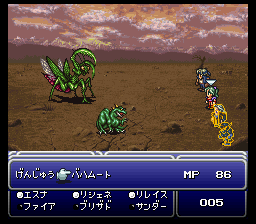 |
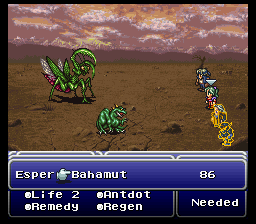 |
The Esper battle window in the Japanese version displays MP next to the digits. This is for some reason absent in the North American version, where the digits also have been slightly repositioned.
Character Names
| Japanese | North American |
|---|---|
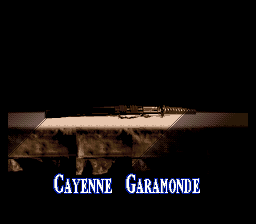 |
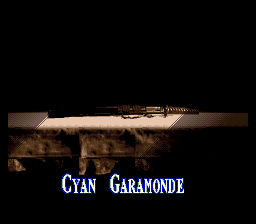 |
| Japanese | North American |
|---|---|
 |
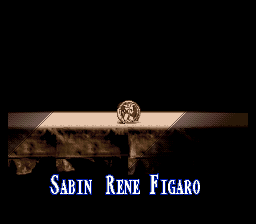 |
| Japanese | North American |
|---|---|
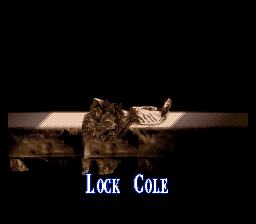 |
 |
| Japanese | North American |
|---|---|
 |
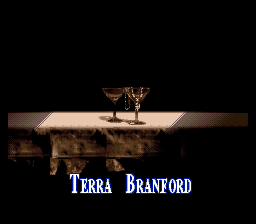 |
| Japanese | North American |
|---|---|
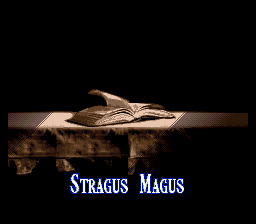 |
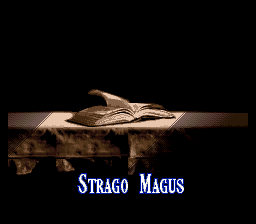 |
Credits
The end credits were updated with new names in the "special thanks" category.
| Japanese | North American |
|---|---|
| T.MIYAKE M.OOHARA F.NISHIKAWA A.TAKAHASHI M.NAGAI Y.KOYAMA K.SHINODA |
RICH SILVEIRA TOSHI HORII J.YANAGIHARA DOUG SMITH JAMES GILLIS |
| Japanese | North American |
|---|---|
| T.KONDO H.KASUGA T.TSUYUZAKI J.CHIHARA T.YAMAZAKI R.SAKAKIBARA N.SHIMAMURA |
CHRIS BUDD MIKE MARKEY MIRKO FREGUIA NATHAN WILLIAMS DALEN ABRAHAM |
| Japanese | North American |
|---|---|
| REBECCA COFFMAN BRIAN FEHDRAU JEFF PETKAU GEORGE SINFIELD ALAN WEISS |
As the North American version is one title card longer, it causes Nobuo Uematsu's score to be slightly out of sync with the visuals in the epilogue.
In addition, "Translator Ted Woolsey" was added to both the opening and end credits and a small typo, "Test Coordinater", was corrected to "Test Coordinator".
Other Changes
- The MP growth curve was modified in the North American version, resulting in lower MP values overall (most notable early on in the game).
- Like the two earlier games localized at the time, the currency Gil is known as GP in the North American version.
- In the Japanese version, the characters all have class names next to their portrait in the menus.
- The Merit Award was changed to be incompatible with the Atma Weapon (Ultima Weapon) in the North American version. This was reverted for the PlayStation version and subsequent releases.
- Pages missing developer references
- Games developed by Square
- Games developed by TOSE
- Pages missing publisher references
- Games published by Square
- Games published by Squaresoft
- Games published by Square EA
- Games published by SCEE
- Games published by SCE Australia
- SNES games
- PlayStation games
- Pages missing date references
- Games released in 1994
- Games released in April
- Games released on April 2
- Games released in October
- Games released on October 11
- Games with unused enemies
- Games with unused graphics
- Games with unused items
- Games with unused abilities
- Games with unused music
- Games with unused text
- Games with regional differences
- Games with revisional differences
- Pages with a Data Crystal link
- Featured articles
- Featured main articles
- To do
- Final Fantasy series
Cleanup > Pages missing date references
Cleanup > Pages missing developer references
Cleanup > Pages missing publisher references
Cleanup > To do
Games > Games by content > Games with regional differences
Games > Games by content > Games with revisional differences
Games > Games by content > Games with unused abilities
Games > Games by content > Games with unused enemies
Games > Games by content > Games with unused graphics
Games > Games by content > Games with unused items
Games > Games by content > Games with unused music
Games > Games by content > Games with unused text
Games > Games by content > Pages with a Data Crystal link
Games > Games by developer
Games > Games by developer > Games developed by Square Enix > Games developed by Square
Games > Games by developer > Games developed by TOSE
Games > Games by platform > PlayStation games
Games > Games by platform > SNES games
Games > Games by publisher > Games published by Electronic Arts
Games > Games by publisher > Games published by Sony > Games published by Sony Interactive Entertainment > Games published by Sony Computer Entertainment > Games published by SCEE
Games > Games by publisher > Games published by Sony > Games published by Sony Interactive Entertainment > Games published by Sony Computer Entertainment > Games published by SCE Australia
Games > Games by publisher > Games published by Square Enix > Games published by Square
Games > Games by publisher > Games published by Square Enix > Games published by Square > Games published by Square EA
Games > Games by publisher > Games published by Square Enix > Games published by Square > Games published by Squaresoft
Games > Games by release date > Games released in 1994
Games > Games by release date > Games released in April
Games > Games by release date > Games released in April > Games released on April 2
Games > Games by release date > Games released in October
Games > Games by release date > Games released in October > Games released on October 11
Games > Games by series > Final Fantasy series
The Cutting Room Floor > Featured articles
The Cutting Room Floor > Featured articles > Featured main articles




